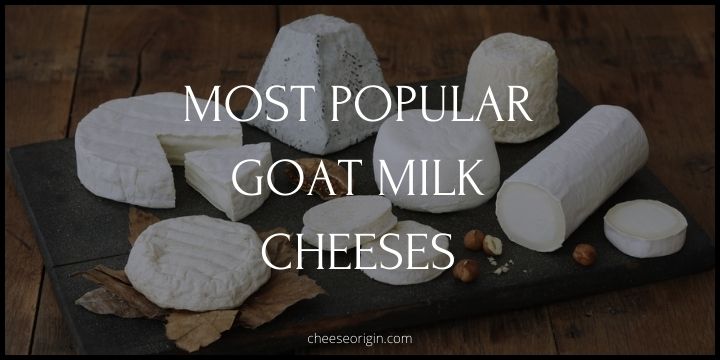10 Most Popular Cheeses Originated in Spain

Spain, a country renowned for its rich culinary traditions and diverse gastronomic delights, is the birthplace of some of the world’s finest cheeses. With each region boasting its unique cheese varieties, Spain offers a cornucopia of tastes, aromas, and textures to delight every cheese lover’s palate.
This article dives into the world of Spanish cheese, exploring the top 10 most popular cheeses that have originated from this vibrant nation. From the robust and nutty Manchego to the creamy Tetilla and the uniquely crafted Galmesano, we will take you on an unforgettable journey through the aromatic landscapes of Spanish cheesemaking.
The 10 Most Popular Spanish Cheeses (BEST)
| Cheese | Short Description | Tasting Profile |
|---|---|---|
| Manchego | A hard cheese made from sheep’s milk in the La Mancha region. | Strong, spicy, and pungent. |
| Cabrales | A blue cheese from Asturias, made from a blend of cow, sheep, and goat’s milk. | Smoky, nutty, and rich. |
| Mahón | Named after the port of Mahón on Menorca island, its taste varies with age. | Ranges from mild to strong flavor. |
| Idiazábal | A smoky, nutty cheese from the Basque and Navarra regions, made from sheep’s milk. | Mild, creamy, and slightly tangy. |
| Queso de Burgos | A soft, white cheese from Burgos, in the Castilla y León region, made from sheep’s milk. | Creamy, slightly bitter, and rich. |
| Torta del Casar | A creamy, slightly bitter cheese from Extremadura, made from sheep’s milk. | Piquant, buttery, and slightly salty. |
| Queso Iberico | A mixed-milk cheese (cow, sheep, and goat) from the La Mancha region. | Buttery, slightly piquant, and crumbly. |
| Queso Zamorano | A cheese made from ewe’s milk in Zamora, it has a crumbly texture. | Mild, creamy, and slightly sweet. |
| Queso Tetilla | A mild, creamy, cow’s milk cheese from Galicia, known for its peculiar ‘breast’ shape. | Nutty, salty, and granular. |
| Galmesano | A hard, granular cheese from Mallorca, made with sheep’s milk and similar to Parmesan. | Nutty, salty and granular. |
1. Manchego
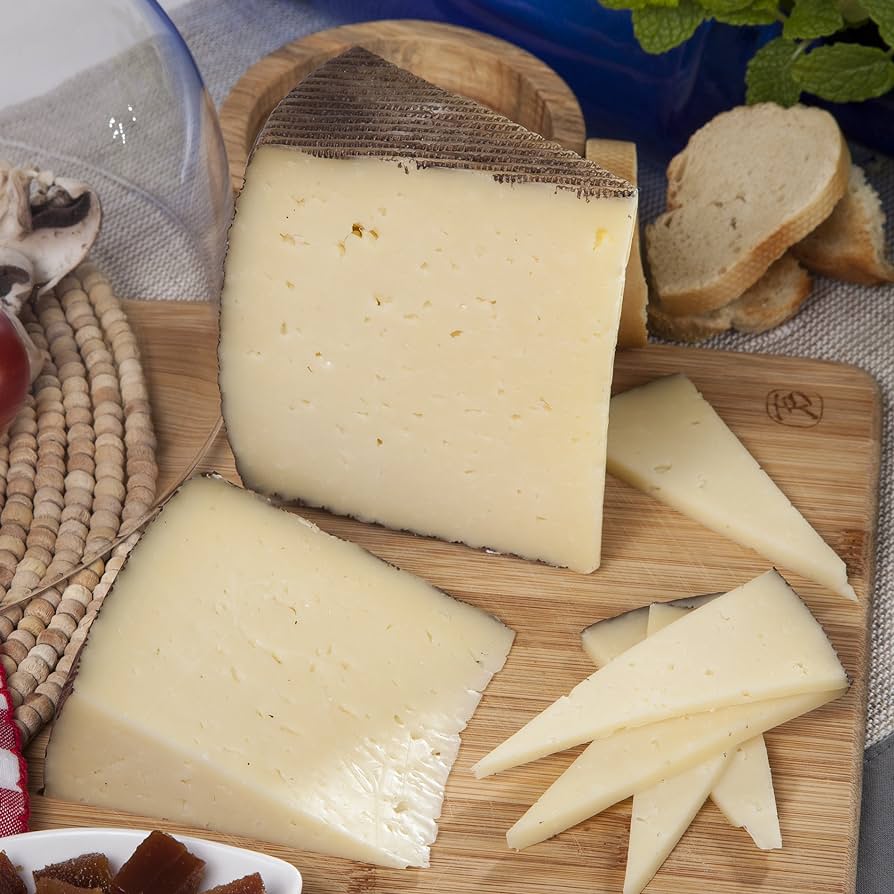
- Milk Type: Sheep’s milk.
- Taste: Nutty and slightly fruity.
- Texture: Firm and crumbly.
- Food Pairing: Pairs well with Marcona almonds, quince paste, and crusty bread.
- Wine Pairing: Complements full-bodied reds like Rioja or Tempranillo.
- Read in-depth guide
Manchego is a distinctive cheese from the La Mancha region of central Spain. It’s exclusively made from the milk of the Manchega sheep breed, which is native to the area. This cheese is aged for a duration ranging from 60 days to up to 2 years, resulting in a variety of flavor profiles.
Manchego has a slightly sweet, firm, and nutty flavor that sets it apart from cow’s milk cheeses. Its rich, buttery taste and firm texture have made it a favorite across Spain and beyond. This cheese is versatile and can be enjoyed by both connoisseurs and those new to exploring different cheese types due to its unique yet accessible flavor profile.
2. Cabrales

- Milk Type: A blend of cow, sheep, and goat’s milk.
- Taste: Strong, spicy, and pungent.
- Texture: Crumbly to slightly creamy.
- Food Pairing: Great with robust breads, fruits like apples and pears, or melted over steak.
- Wine Pairing: Works well with strong red wines, sherry, or robust cider.
- Read in-depth guide
Cabrales originates from the rural region of Asturias, where it’s crafted by artisanal dairy farmers. This robust cheese is made from a blend of unpasteurized cow’s, sheep’s, and goat’s milk, sourced exclusively from herds raised in the mountainous zone of Asturias. The unique taste of Cabrales ranges from acidic to salty, offering a pungent flavor that lingers on your palate.
It’s aged in caves near the Cantabrian Sea, under cold and humid conditions, which contributes to its creamy texture and earthy notes. Notably, Cabrales holds a place in gastronomic history as one of the most valuable cheeses ever sold at auction, reflecting its esteemed position among cheese aficionados worldwide.
3. Mahón
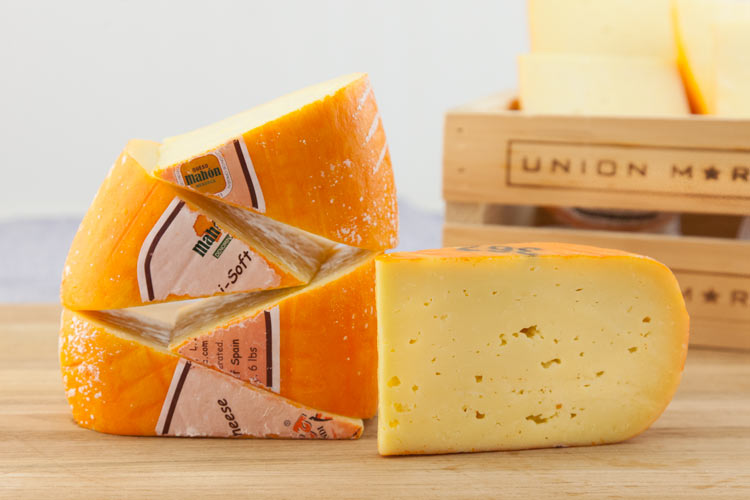
- Milk Type: Cow’s milk.
- Taste: Varies from mild to strong depending on age.
- Texture: Soft to hard based on aging.
- Food Pairing: Delicious with fig jam, olives, or simple crackers.
- Wine Pairing: Pairs nicely with medium-bodied reds, whites, or rosé wines.
Mahón is a delightful Spanish cheese named after the port city of Mahón on the island of Menorca. It’s crafted from cow’s milk, ranging from fresh to aged varieties. The younger version of Mahón is softer with a creamy, buttery flavor profile, while the matured version is hard with a sharp, salty, and slightly spicy flavor.
Aged Mahón also develops an aromatic complexity that adds an exciting layer to its overall taste. This cheese is typically square-shaped and possesses an orange rind, which is a result of being rubbed with paprika and oil during the aging process.
With its versatile nature, Mahón can fit into various culinary applications, from grating over pasta to pairing with fruit or quince jam for a delectable dessert.
4. Idiazábal
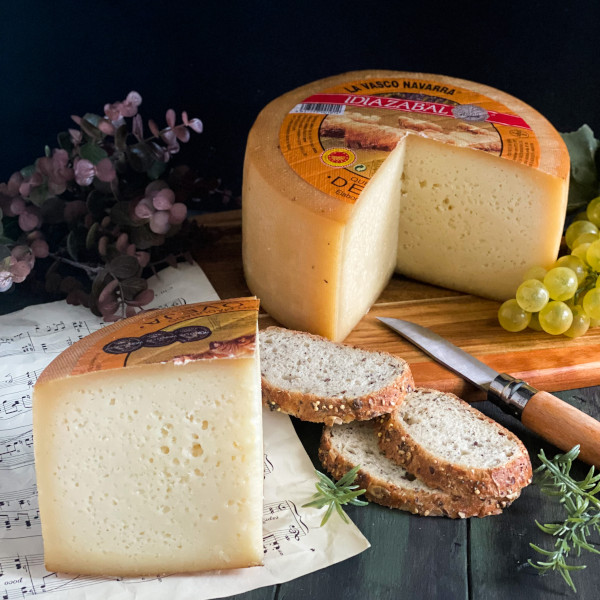
- Milk Type: Sheep’s milk.
- Taste: Smoky and nutty.
- Texture: Hard and compact.
- Food Pairing: Complements grilled vegetables, cured meats, or as a topping for pasta.
- Wine Pairing: Matches well with robust red wines or dry white wines.
- Read in-depth guide
Idiazábal is a celebrated cheese hailing from the Basque and Navarre regions of Northern Spain. It’s a hard, smoked cheese made exclusively from the milk of Latxa and Carranzana sheep, breeds known for their rich, high-fat milk. The cheese is aged for a minimum of two months, during which it develops a dense, slightly dry texture and a nutty, buttery flavor with a distinct hint of smokiness.
Idiazábal is recognized for its characteristic cylindrical shape and a dark, hard rind that encases its pale yellow interior. Whether enjoyed as a standalone snack, paired with quince paste, or incorporated into traditional Basque dishes, Idiazábal offers a unique taste of Spanish heritage.
5. Queso de Burgos
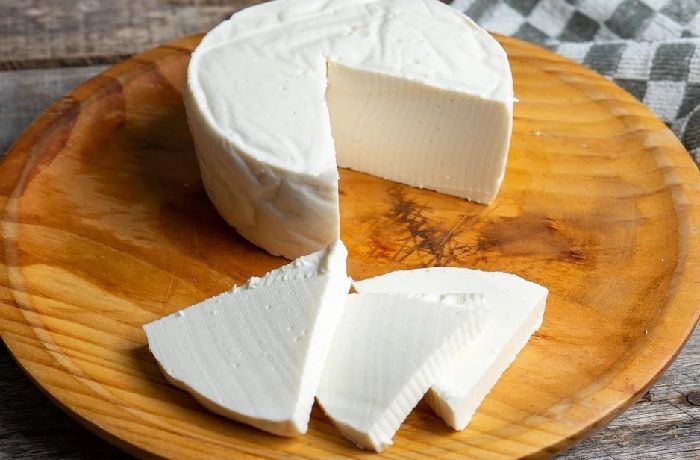
- Milk Type: Sheep’s milk.
- Taste: Mild and slightly tangy.
- Texture: Soft and creamy.
- Food Pairing: Perfect with honey or fruit preserves, or in salads.
- Wine Pairing: Goes well with light-bodied white wines or sparkling wines.
Queso de Burgos, or Burgos cheese, is a distinct cheese named after the province of Burgos in the Castille-Leon region. This cheese is renowned for its pure, white color and soft, aqueous texture, which is a result of being sold with the milk’s whey.
Although originally crafted with sheep’s milk, it’s now commonly made with pasteurized cow’s milk or a mix of cow’s and sheep’s milk. The taste of Queso de Burgos is mild, featuring fresh milk flavors that make it a versatile addition to various dishes.
As a testament to its cultural significance, only cheese made in Burgos can legally bear the name ‘Queso de Burgos’, ensuring the quality and authenticity of this beloved Spanish delicacy.
6. Torta del Casar
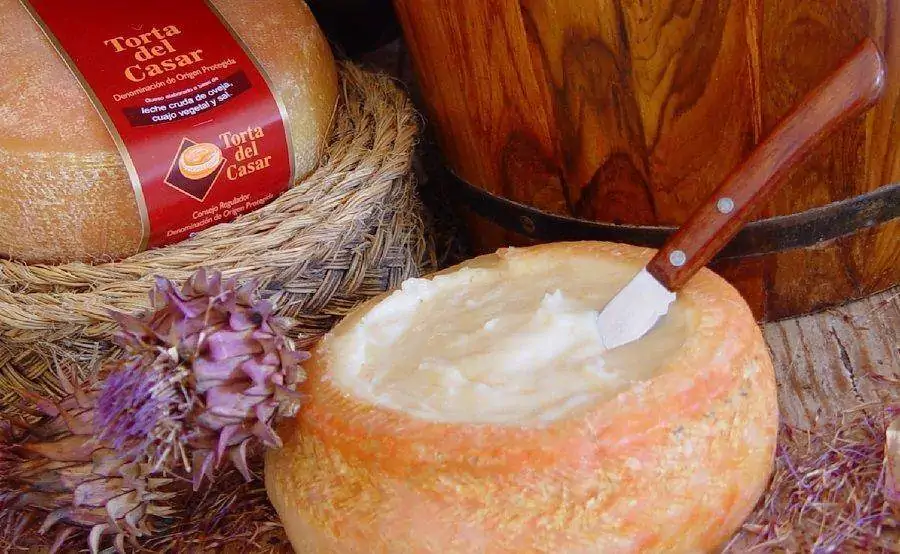
- Milk Type: Sheep’s milk.
- Taste: Creamy and slightly bitter.
- Texture: Soft and spreadable.
- Food Pairing: Delicious with rustic bread or used as a dip for vegetables.
- Wine Pairing: Pairs well with robust red wines or sherry.
Torta del Casar is a highly prized cheese originating from the region of Extremadura. It’s a sheep’s milk cheese, known for its unique creamy and slightly runny texture, often scooped out with a spoon. The cheese is matured for at least 60 days, during which it develops a strong, complex flavor that perfectly balances bitter and sour notes with a salty finish.
The rind of Torta del Casar is natural and mold-ripened, contributing to its distinct taste and appearance. This cheese is typically served as a standalone dish or spread on bread, offering a rich, indulgent experience that captures the essence of Spanish cheesemaking tradition.
7. Queso Iberico
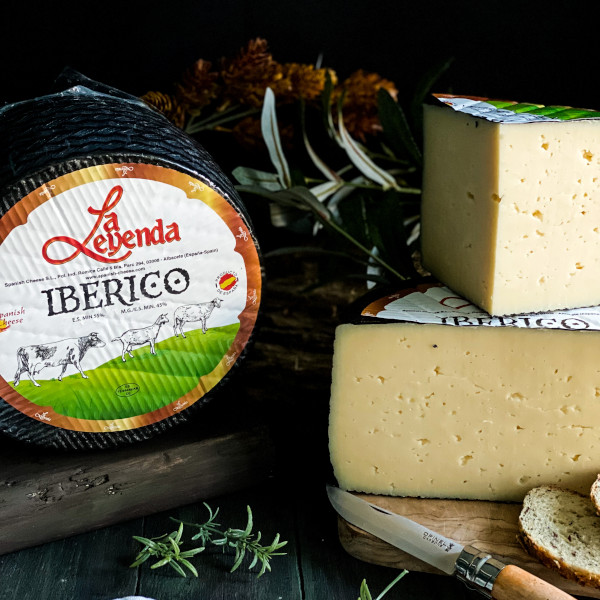
- Milk Type: A blend of cow, sheep, and goat’s milk.
- Taste: Piquant, buttery, and slightly salty.
- Texture: Semi-hard and compact.
- Food Pairing: Complements cured meats, olives, or crusty bread.
- Wine Pairing: Matches well with medium-bodied reds or dry white wines.
- Read in-depth guide
Queso Iberico is a versatile and well-balanced cheese that is named after the Iberian Peninsula. It’s a mixed-milk cheese, made from a blend of cow’s, sheep’s, and goat’s milk, with the proportions varying based on the time of year and availability of milk. This leads to a unique flavor profile that combines the creaminess of cow’s milk, the tanginess of goat’s milk, and the richness of sheep’s milk.
Queso Iberico has a firm yet supple texture, and its taste is mild to medium with a slightly piquant finish. The cheese is typically aged for about three months and features a natural, edible rind. Whether served on a cheese platter, melted in dishes, or paired with wine, Queso Iberico offers a harmonious blend of flavors reflective of its diverse origins.
8. Queso Zamorano
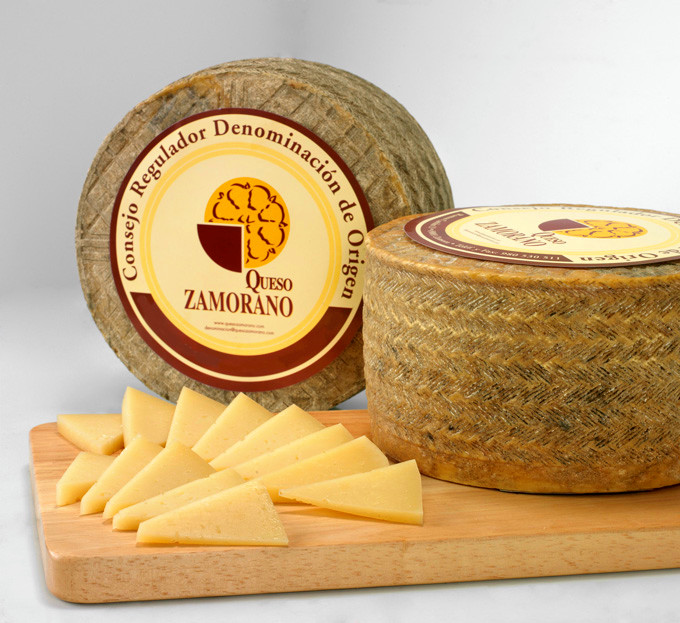
- Milk Type: Ewe’s milk.
- Taste: Buttery and slightly piquant.
- Texture: Firm and crumbly.
- Food Pairing: Perfect with quince paste, almonds, or hearty breads.
- Wine Pairing: Pairs nicely with full-bodied red wines like Ribera del Duero.
- Read in-depth guide
Queso Zamorano is a distinguished cheese hailing from the province of Zamora in the Castilla y León region. This hard cheese is traditionally made from the milk of Churra and Castellana sheep breeds, ensuring a robust and full-bodied flavor. The cheese undergoes a maturing process of about six months, during which it develops an intense and well-developed aroma and flavor.
Queso Zamorano is recognized by its distinctive wheel shape and a herringbone pattern imprinted on the rind. It holds a protected designation of origin (D.O.P), ensuring that only cheeses produced in this specific region can carry the esteemed name of ‘Queso Zamorano.’ Its rich history and unique characteristics have earned it a prominent place within Spanish gastronomy.
9. Queso Tetilla
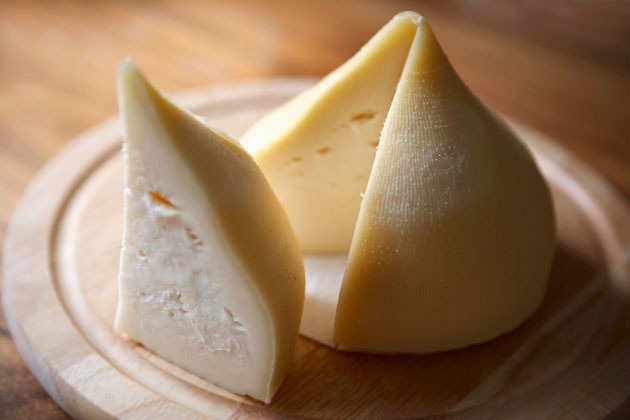
- Milk Type: Cow’s milk.
- Taste: Mild and slightly sweet.
- Texture: Soft and creamy.
- Food Pairing: Delicious with fresh fruits or honey.
- Wine Pairing: Goes well with light-bodied white wines or fruity red wines.
- Read in-depth guide
Queso Tetilla is a traditional cheese that originates from Galicia. Made primarily from the milk of Friesian, Swiss Brown, and Galician Blonde cows, this cheese is known for its unique conical shape, which gives it its name ‘Tetilla,’ translating to ‘small breast.’ It’s a semi-soft cheese, characterized by its creamy and buttery texture, making it perfect for spreading on a piece of bread or melting over dishes.
The cheese features a smooth, straw-colored rind and minimal air pockets within its body. Since 1992, Queso Tetilla has been one of the four kinds of cheese from Galicia with a protected designation of origin (D.O.), ensuring its quality and authenticity. Its gentle and slightly tart flavor profile makes it a delightful addition to any cheese board.
10. Galmesano
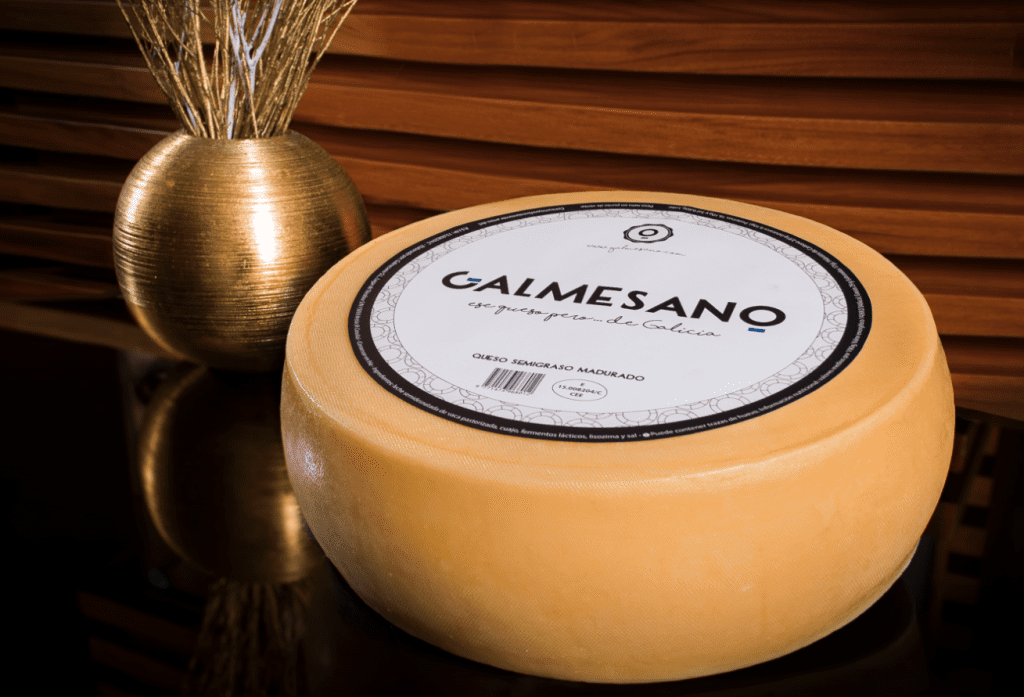
- Milk Type: Sheep’s milk.
- Taste: Nutty and salty.
- Texture: Hard and granular.
- Food Pairing: Perfect grated over pasta or risotto, or with fig jam.
- Wine Pairing: Pairs excellently with robust red wines or aged white wines.
Galmesano is a unique and special cheese originating from Spain’s Balearic Islands. This artisanal cheese, crafted in the style of Italian Parmesan, is made from the milk of local Menorcan cows. The cheese is traditionally aged for over 12 months, resulting in a hard texture similar to Parmigiano-Reggiano.
Its distinctive flavor profile includes a blend of rich, nutty, and slightly fruity notes, which deepen with aging. Galmesano features a natural rind and a straw-yellow interior dotted with tiny holes. Its granular texture makes it an excellent cheese for grating over pasta dishes, risottos, or salads. Galmesano is not just a cheese, but a testament to the fusion of Mediterranean culinary traditions.
Final Thoughts
As we conclude our delicious journey through the heart of Spain, it’s clear to see why these 10 cheeses have captured not just the taste buds, but also the hearts of both locals and international food enthusiasts alike. They are more than just a staple in the Spanish diet; they are a testament to centuries-old traditions, local craftsmanship, and a deep-rooted love for quality and flavor.
We hope this exploration of Spain’s most popular cheeses has inspired you to expand your culinary horizons. Perhaps it will even ignite a desire to visit these regions and experience the process of cheesemaking firsthand.
Also read:
- 7 Most Popular Cheeses Originated in Slovakia
- 10 Most Popular Cheeses Originated in Poland
- 10 Most Popular Cheeses Originated in Norway
- 10 Most Popular Cheeses Originated in the Middle East
- Top 5 Most Popular Cheeses in Lithuania
- 10 Most Popular Cheeses Originated in Italy
- 9 Most Popular Cheeses Originated in India

